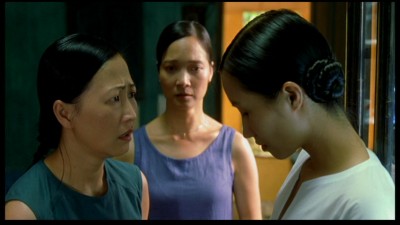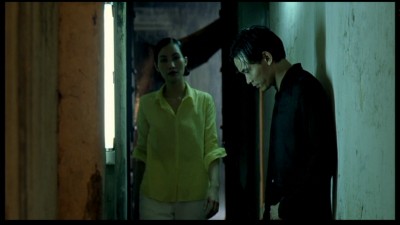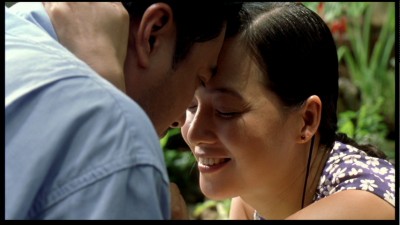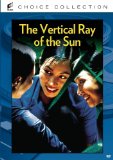| Reviews & Columns |
|
Reviews DVD TV on DVD Blu-ray 4K UHD International DVDs In Theaters Reviews by Studio Video Games Features Collector Series DVDs Easter Egg Database Interviews DVD Talk Radio Feature Articles Columns Anime Talk DVD Savant Horror DVDs The M.O.D. Squad Art House HD Talk Silent DVD
|
DVD Talk Forum |
|
|
| Resources |
|
DVD Price Search Customer Service #'s RCE Info Links |
|
Columns
|
|
|
Vertical Ray of The Sun, The
THE MOVIE:

The Vertical Ray of the Sun, the 2000 drama from Vietnamese director Tran Anh Hung (Norwegian Wood), is an artfully conceived, beautifully realized cinematic poem, a story of life that could be compared to Wong Kar-Wai or Hou Hsiao-hsien, both masters of the blithe rhythms that Hung so effortlessly dances to. Yet, The Vertical Ray of the Sun is also very much representative of a singular voice, of a tone that indicates the artist's assurance of his own perceptions and his willingness to trust his instincts.
The film is the story of three sisters: Suong (Nhu Quyn Nguyen, The Chinese Botanist's Daughter), the eldest, a mother and cafe owner, who is married to a photographer; Khanh (Le Khanh) is in the middle, the wife of a writer, secretly a mother-to-be; and Lien (Tran Nu Yên-Khê, Cyclo), the baby, ostensibly the film's star, a student of life, a girl in the state of becoming. Lien lives with her half-brother, Hai (Quang Hai Ngo), who was born on the same day as her, though the hour is unknown, meaning there is no older or younger here, they are almost a single being. Lien and Hai are close, possibly too close, living like lovers yet without the lovemaking. Lien crawls into his bed every night when she gets cold; Hai pretends to be annoyed. The Vertical Ray of the Sun's narrative shifts are punctuated by lovely, languorous scenes of this girl and boy waking up in the morning, leisurely attending to their routine, buoyed by the sounds of the Velvet Underground and Arab Strap. To complete the triumvirate of artistic men, Hai is a film actor. He and Lien playfully practice a scene he will shoot later that night, two lovers silently parting.
It is a moment that will be repeated further down the line, when Lien has a tough talk with a legitimate suitor, and it's one of many such redos. The Vertical Ray of the Sun is a film that is full of echoes and overlapping, parallel experiences. Actions reverberate, and similar instances emerge in the ripples, crossing over one another until the connections and cohesions create a perfect whole. The script is built from an occasio where the sisters gather to prepare a memorial for their dead mother, a woman whom they have recently discovered had a secret love buried deep in her past. Their desire to know about her becomes our gateway to know about them, an invitation to peer into their secret lives. Is Suon as happily married as people imagine, or does she have a lost romance like her mother? Will Khanh's husband (Manh Cuong Tran) succumb to temptation like the protagonist of his novel? How will this all affect Lien, who reverberates with desire, but who hasn't the practical knowledge to do anything about it? In the role, Tran Nu Yên-Khê is both innocent and seductive, absorbing experience but also radiating it. She is like a tuning fork reacting to all emotional stimulus, while being careful to give up what she feels herself. Yên-Khê is mesmerizing to watch, as complex as her sisters, yet without the externalized drama.

I am somehow not surprised to discover that cinematographer Ping Bin Lee (a.k.a. Mark Lee), one of the cameraman on In The Mood for Love and also Hou Hsiao-hsien's cinematographer on Three Times and Flight of the Red Balloon, among others, is the man behind the lens here. His photography is gorgeous, like Edward Hopper painting with neon pens. It was by no accident, then, that I had flashbacks to Maggie Cheung and Tony Leung waiting out a rainstorm while watching Yên-Khê and Ngo do the same. There is a shared tradition connecting the films by all of these filmmakers. Lien could just as easily be a stand-in for Shu Qi in Millennium Mambo (shot by Lee, as well), a young woman both out of her time and very present in it.
Of course, all this beauty would be useless if channeled into disparate melodies and aimless improvisation. The remarkable thing about The Vertical Ray of the Sun, where it derives its considerable impact, is how Hung pulls it all together. The girls who were brought closer by their mother's covert passions are further bonded by their own passions, and specifically by their desire to create new life themselves, to continue the tradition of mother and daughter (or son). It's in the shared, alleviating moment when pregnancies, both actual and imagined, are revealed that we see all three women for their different facets, how they represent roots of the same tree, growing from the same source, yet divergent, emblematic of the possibilities inherent in all things. No matter how differently they may travel, their paths are still wending their way through the same soil. And so it is that a cycle passes, a year turns, and the next phase begins.

THE DVD
Video:
The Sony Choice Collection, the studio's manufacture-on-demand label, brings The Vertical Ray of the Sun to DVD as a color, widescreen transfer. The image quality is average. Lines and edges tend to be soft, but the colors are warm and lovely and there are no blemishes on the screen. Honestly, I like this movie way more than The Scent of Green Papaya, Tran Anh Hung's most popular film, which I previously reviewed on Blu-Ray, and find it sad that it can't get the same kind of love and attention paid to this. I'd watch this again a million times more than I'd watch Green Papaya.
Sound:
The 5.1 original language soundtrack is surprisingly good, with lots of ambient effects that create a realistic atmosphere that moves gently throughout the room. There are no dropouts or glitches. The subtitles are yellow and, though easy to read, slightly pixilated. I should note, I hate it when movies like The Vertical Ray of the Sun don't translate the songs that characters sing onscreen, somehow assuming they aren't integral to the film's plot.
Extras:
Just a trailer.
FINAL THOUGHTS:
Highly Recommended. This turn-of-the-century effort from Vietnamese filmmaker Tran Anh Hung is a moving story of three sisters at different stages of life, struggling with their relationships and the harsh lessons of age. Beautifully shot and lyrically composed, The Vertical Ray of the Sun is a film that is all about feeling, about human connections and the way we touch each other's lives, both to the good and bad. Led by three remarkable actresses, the film weaves multiple stories together, letting each influence and comment on the others. It's a lovely piece of cinema.

Jamie S. Rich is a novelist and comic book writer. He is best known for his collaborations with Joelle Jones, including the hardboiled crime comic book You Have Killed Me, the challenging romance 12 Reasons Why I Love Her, and the 2007 prose novel Have You Seen the Horizon Lately?, for which Jones did the cover. All three were published by Oni Press. His most recent projects include the futuristic romance A Boy and a Girl with Natalie Nourigat; Archer Coe and the Thousand Natural Shocks, a loopy crime tale drawn by Dan Christensen; and the horror miniseries Madame Frankenstein, a collaboration with Megan Levens. Follow Rich's blog at Confessions123.com.
|
| Popular Reviews |
| Sponsored Links |
|
|
| Sponsored Links |
|
|
| Release List | Reviews | Shop | Newsletter | Forum | DVD Giveaways | Blu-Ray | Advertise |
|
Copyright 2024 DVDTalk.com All Rights Reserved. Legal Info, Privacy Policy, Terms of Use,
Manage Preferences,
Your Privacy Choices | |||||||













